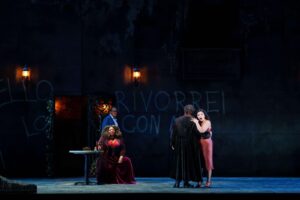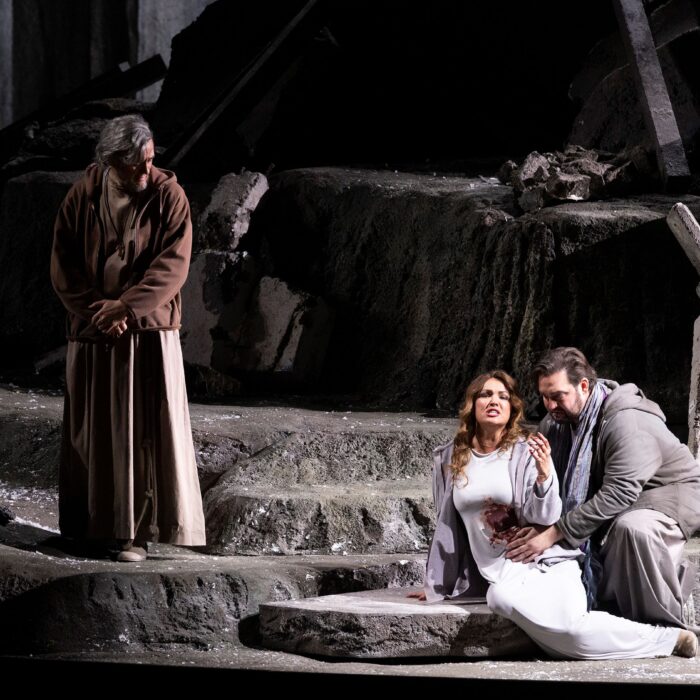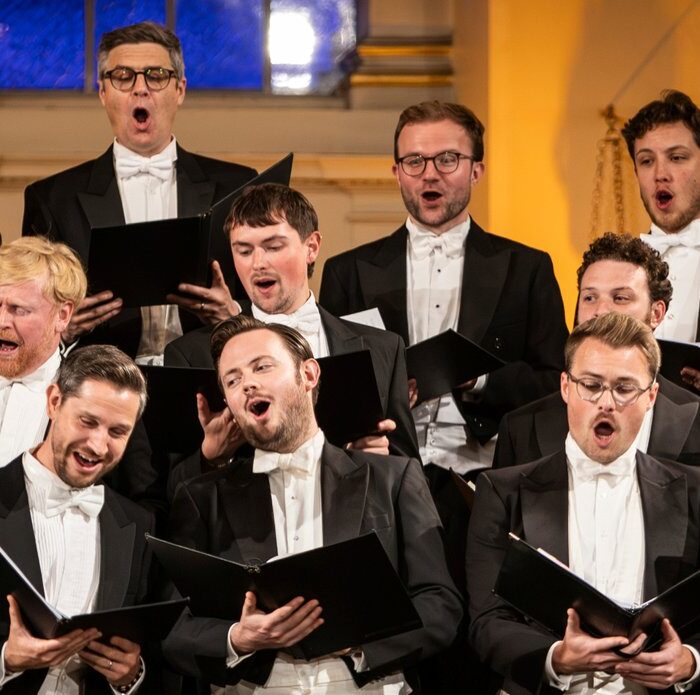
Houston Grand Opera 2024-25 Review: Il Trovatore
Lucas Meachem & Ailyn Pérez Spotlight Houston’s New Production of Verdi’s Masterpiece
By Francisco Salazar“Il Trovatore” is one of Verdi’s most popular operas and it is said that to do it justice, all you need are the four greatest voices in the world. The opera certainly packs a punch for all four soloists as it requires agility, legato, and expressiveness throughout their respective ranges. Its story is also known for being “incomprehensible” and hard to understand yet more than anything it is a melodrama that sometimes gets too much over-explanation. Verdi simply does the job with his powerful and catchy melodies and gut-wrenching finale.
So when Houston Grand Opera decided to revive the work it had not shown since the 2012-13 season, the company brought a starry cast of some of today’s leading singers and a new production by one of opera’s greatest directors.
It should have been a slam dunk but was anything but proving a mixed bag in its musical approach and production.
Bel Canto Verdi
Patrick Summers’ big choice here was to implement a bel canto style where the music felt more in line with Bellini and Donizetti’s orchestras. Tempos were rapid. They worked in the cabalettas and the faster sections like Leonora and the Count’s duet and the trio, but in the slower legato arias, this choice felt too fast and didn’t give the singers the space to breathe. The bel canto approach allowed the singers not to force their voices but sometimes the “oomph pah pahs” in the accompaniment were over-emphasized. I also felt that the approach undercut the power of Verdi’s music, especially in sections like “Condotta ell’era in ceppi” and the finale.
The other issue I had was the implementation of ornaments and variations in the music. Throughout the history of “Il Trovatore” interpolations have been used but in very sparing moments. On this night, it seemed like every aria and cabaletta needed to have some type of interpolation to the point where the music could sometimes feel uneven and unrecognizable. The cadenzas at the end of “Ah! si ben mio” and “D’amor sull’ali rosee” were awkward and the interpolations at the end of “Di tale amor” and “di quella pira” undercut the powerful codas of these pieces. The fioritura and interpolations worked during the interlude of the repeat of “Di tale amor,” in the “Miserere” during the repetition of “Di te, di te scordarmi!!…,” and during the Count-Leonora duet as Leonora is about to drink the poison.
But perhaps what most annoyed me was the use of the same cuts that have become a tradition. With Summer’s interest in a new approach, I wish that he would have gotten rid of the cuts and given us not only a Bel Canto approach but a critical edition of the work.
Vibrant & Lyric
Lucas Meachem brought his formidable lyric tone to the role of Count di Luna. Given that his sound does not have the same gruffness as most Verdi baritones, the lightness allowed this Count to have a softer side that is generally not seen in the character. That was best displayed in his “Il balen del suo sorriso” which Meachem sang with gorgeous legato lines as he melted one line into the next. His sound didn’t seem to go louder than a mezzo forte and he delighted in letting each line ring for as long as he could. What was most impressive was how he could easily float each phrase and never lose the sensitivity in the tone. But in his following cabaletta “Per me, ora fatale,” he displayed a heroic timbre and easiness with his higher register.
In Act three and four, you could finally see a crueler side to this Count. During the trio with Azucena in Act three, Meachem showcased a more potent sound complemented by staccato phrasing. Then in the duet with Ailyn Pérez’s Leonora, Meachem displayed drive and flexibility as he dispatched each line with accents emphasizing the Count’s anger. The final scene was moving as Meachem’s Count went from anger and vengeful to remorseful at the discovery that he has murdered his own brother.
One thing that I did not care for in Meachem’s interpretation was his choice to begin some lines with a straight tone, especially in the lighter moments like his entrance “Tacea la Notte.” It just felt characteristically out of every style being performed.
Also appealing on this night was Ailyn Pérez who is singing her first Leonora. What is to be admired about this artist is her grit and energy on stage. She begins the opera as a young woman intoxicated by love, twirling on stage as she sings her first aria. By Act two, she becomes mournful and solemn. But that changes in the concertato where Pérez played it as if she was in a daydream, completely sucked in by the sight of her lover Manrico. By Act four, she is a woman who will do anything for love. The intensity of each movement was on full display throughout this final act.
Vocally Pérez played to her strengths, especially with her use of text. You could understand every word and every phrase she was going for. Sometimes she would emote certain lines like in the chest voice phrases of “Miserere” and she would employ accents in “Di tal amor” to emphasize the effect of her love for Manrico. It wasn’t the typical Verdi phrases one is used to but they were effective for the most part.
Her opening “Tacea la notte placida” was sung with a creamy legato line that flowed with ease as she climbed to the higher passages of her voice and expanded the phrase with ease. She began the second repeat of the A melody, “Versi di prece ed umile,” with a gentle piano that slowly crescendoed to forte on “La terra un ciel sembrò.” She also inserted a beautiful portamento before the line “Gioia provai che agli angeli.” It was admirable and virtuosic to see Perez repeat the “Di tal amor,” and while one would have liked more flexibility in the coloratura lines that ascended into the higher range, her incandescent charm was on display in this cabaletta. In the Act two concertato, Pérez employed a staccato line for “E deggio… e posso crederlo” and then juxtaposed it with a gorgeous legato on “Sei tu dal ciel disceso” that slowly built to the forte at the end.
But it was in Act four that Pérez came into her own and demonstrated her greatest strengths. Her “D’ amor sull’ ali rosee” was a masterclass in legato phrases and colors. Pérez delicately began each line with a soft piano before moving into her high range and crescendoing to a forte. The aria also allowed for ebb and flow as she slowed down in certain phrases especially “ai sogni dell’amor!” giving her space to express each word. And then were her ascensions into the higher range as she repeated the phrase “le pene del mio cor!” Here Perez floated the notes with a piano sound and slowly cresceondoed each repetition of the phrase to a forte. Here Summers did give the soprano time to expand upon the phrase and the result was one of the biggest ovations of the night.
Her ensuing “Miserere” was a complete contrast as it saw the soprano digging into the text and imbuing the line with a grittier sound as she emoted some of the lines and emphasized the staccato phrases in the music, especially the opening “Quel suon, quelle preci solenni, funeste.” And that was followed with a “Tu vedrai che amore in terra” that was forceful and forward-moving. Some of the coloratura was a bit smudged and some of the high notes, particularly the final C, did get a little rough.
In the following duet with Meachem, both Pérez and the baritone were in synch dramatically, glancing at one another constantly, Meachem with desire and Pérez with fear and resolution. As they acted the hell out of the duet, you couldn’t help but admire the way they managed the incredibly rapid tempi in “Mira, di acerbe lagrime” and “Vivra contende il giubilo” with tremendous agility, never missing a single note. Pérez spun the coloratura lines with clarity, while Meachem contrasted with staccato phrases. It was perhaps one of the most dramatic moments of the night.
Pérez’s night ended with a heartbreaking final trio where she once again spun gorgeous floating notes in the lines “Prima che d’altri vivere…” and “Io volli tua morir!…”
Morris Robinson portrayed Ferrando with his booming voice and during his opening aria, he displayed virtuosic flexibility as well as an enormous tone. Elizabeth Hanje’s Ines brought out a promising sound while Demetrious Sampson Jr. was solid as Ruiz.
Mixed Bags
In the title role, Michael Spyres gave a fine showcase of elegance and bel canto. His opening Serenade, “Deserto sulla terra” was sung with a suave legato line that emphasized the tenor’s ardent tone and his flexibility through his range. In the subsequent trio, he was agile and sang with precision, carefully matching Perez’s tone. But in the duet with Azuena in Act two, Spyre’s singing retreated to cautious phrasing and a covered top. Spyres phrased with delicacy and spun the lines with warmth but the singing was missing that emotional quality that Raehann Bryce-Davis was attempting to give, making for an unbalanced pairing.
In his big moment in “Ah! si ben mio” in Act three, Spyres once again demonstrated his expertise in elegance and technical proficiency. The lines were given a silvery shimmer and the middle range brought out his most ardent tone. But as he crescendoed to the top of his register it lacked a ring and the vocal quality became muted. That was similar in the virtuosic “Di Quella Pira.” Props to Spyres who conserved enough breath to sing through both repeats and hit a High C that he extended until the music ended. But once again it seemed as if he was conserving energy and the heroic qualities of his voice never quite came through. The climatic High C was barely audible through the immense chorus and orchestra. What this displayed was technical mastery, but I sometimes missed the fire of Manrico.
It was in the final Act that Spyres finally came through and I felt that he had thrown caution to the wind. He sang with pure passion. His “Madre non dormi? duet was filled with remorse and gorgeous pianissimo singing, while his “Parlar no Voi!” was full of fury and allowed Spyres to finally showcase his ardor. In the trio leading to the final ensemble, Spyres took moments to emphasize certain text with accents especially in “Ha quest’infame l’amor venduto…” and contrasted it with Perez’s emoting “fuggi” and Bryce-Davis’ warm “Ai nostri monti.” It was perhaps his best moment of the night but beautiful and heartbreaking.
In the role of Azucena, Raehann Bryce-Davis showcased raw emotions as the tortured Romani woman. She was on stage throughout the entire first and second act and you could tell her commitment to the character as she transformed from a tortured woman to a vengeful one during the trio. That intensity in her acting was clear throughout the evening but vocally, she often sounded small and underpowered as well as inconsistent and disconnected. Her high range had a trembling tone that could go out of tune while her chest tones were sometimes overemphatic. The middle part of her voice was the most even and was the part where she successfully conveyed the bel canto style. Bryce-Davis was best during the final duet and trio with Manrico and Leonora. Her “Ai nostri monti… ritorneremo…” had a silky quality that was gorgeously phrased and subtle. She was also forceful in her Act three scene with Meachem, once again showcasing her rich middle voice.
Meanwhile, her “Condotta ell’era ceppi” came off as overwrought especially as Bryce-Davis held out the final note way too long and the higher climatic register didn’t come through with the force and power of the aria. Her interpolated note in “Perigliarti ancor languente” had an awkward pause and she took too much time to get to the note.
Modern, Colorful & Interesting
For this run of the opera, Houston chose Stephen Wadsworth to create its new production. Wadsworth noted in his directorial statement that he was inspired by the Basque rebellion that played out 50 years ago in an official attempt to ban the Basque language and culture and all the racial strifes of the modern context. As a result, he set it in modern Spain with a sharp clash of architecture that represents the new and old street culture, racial identity, and political disagreements.
The production works for the most part as it seamlessly moves the action from one scene to the next showing us the interiors of a bar, Azucena’s home filled with picture frames of her past, the outside of an old church, and a graffiti-filled street that functions for the opening scenes and the final prison. There is also a wedding room during the second scene of Act three. The costumes are also quite gorgeous particularly as Leonora begins with a colorful pantsuit to emphasize the youthfulness of her character and slowly her colors turn darker as the opera moves forward. Manrico is dressed in red throughout the night while Di Luna is in blue. Both colors are introduced at the beginning through the two boys who represent Manrico and Di Luna as kids. Ferrando was dressed in a black leather coat while the men’s chorus was dressed in suits emphasizing a gangster element.
Overall the story plays out as it would normally do so with the duel turning into a gunfight with Manrico being shot at the end. The Romani scene that begins Act two plays out with a usual ballet and celebratory chorus, this time in a bar before heading into Azucena’s home where she recounts her story to Manrico. The final concertato that ends Act two is striking in the way Manrico and his men enter from the church creating one of the most tense scenes. Also interesting is that Leonora takes Manrico’s gun and points it at the Duke as she sings her glorious lines.
Act three is also straightforward but the placement of the bedroom is awkward, especially as Manrico sings his “Di Quella Pira” at the side of the stage taking away from the protagonist’s big moment. The final act plays out in an aforementioned graffiti-filled street that adds to the grittiness of the opera. But perhaps one of the greatest touches of the evening was the final trio between Leonora, Manrico, and the Count. Leonora brings Manrico and the Count together for the first time and as she sings her final lines she brings their hands together. It’s a powerful moment that makes the final dramatic turn even more tragic. Another strong touch was that it seemed like the characters were well-formed by the singers, who were given liberties to move about the stage without taking away from their vocal lines.
But Wadsworth’s real innovation in the opera is replaying Azucena’s story. Azucena is put centerstage at the beginning of the opera and we see the story of her mother being burned at the stake followed by the robbery of the old count’s child. It all happens as Ferrando sings his opening aria and we are introduced to the characters in this fashion. Azucena stays on stage throughout the entire first act and then the beginning of the second act and the children return as she tells her story in “Condotta dell’era ceppi” and we see the wrong child being burned. Wadsworth, as he explains in his notes, is trying to clarify the plot that happens before the actual opera. And while it is a good move to help the audience understand, it does take away from the singer’s moments and it becomes inconsistent as Azucena suddenly disappears from the rest of the work except when she has to sing. So the question I was left with was, whether he was trying to tell the story through Azuenca’s point of view or whether he just wanted to clarify the plot. Unfortunately, it ended up being the latter making it, in my opinion, an overexplanation.
Still, it is one of the better productions of this work in recent times. And it got added sparkle from the incredible performances by Meachem and Pérez.


